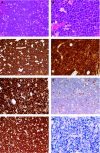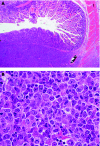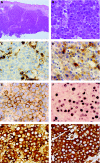HIV infection and lymphoma
- PMID: 18042692
- PMCID: PMC2095580
- DOI: 10.1136/jcp.2007.051953
HIV infection and lymphoma
Abstract
The incidence of lymphoma in patients with HIV infection greatly exceeds that of the general population. The increased risk for lymphoma appears related to multiple factors, including the transforming properties of the retrovirus itself, the immunosuppression and cytokine dysregulation that results from the disease, and, most importantly, opportunistic infections with other lymphotrophic herpes viruses such as Epstein-Barr virus and human herpesvirus 8. Histologically lymphomas fall into three groups: (1) those also occurring in immunocompetent patients; (2) those occurring more specifically in HIV-positive patients; and (3) those also occurring in patients with other forms of immunosuppression. Aggressive lymphomas account for the vast majority cases. They frequently present with advanced stage, bulky disease with high tumour burden and, typically, involve extranodal sites. Clinical outcome appears to be worse than in similar aggressive lymphomas in the general population. However, following the introduction of highly active antiretroviral therapy, the risk for developing lymphoma in the context of HIV infection has decreased and the clinical outcome has improved.
Conflict of interest statement
Competing interests: None declared.
References
-
- Raphael M, Borisch B, Jaffe E. Lymphomas associated with infection by the human immune deficiency virus (HIV). In: Jaffe E, Harris N, Stein H, Vardiman J, eds. World Health Organization classification of tumours, pathology and genetics of tumours of haematopoietic and lymphoid tissues. Lyon, France: IARC Press, 2001260–263.
-
- Rabkin C. Epidemiology of AIDS‐related malignancies. Curr Opin Oncol 19946492–496. - PubMed
Publication types
MeSH terms
LinkOut - more resources
Full Text Sources
Other Literature Sources
Medical




